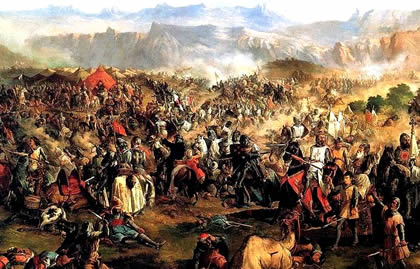 |
| Reconquest of Spain |
In the decades after the prophet Muhammad’s death in 632 c.e., Islam spread rapidly across North Africa, and within a century was knocking on the doors of Europe. In 711 an invading Muslim army crossed the Straits of Gibraltar into Iberia, and by 718 had conquered most of the peninsula.
For the next eight centuries, a complex struggle developed between Iberia’s Islamic caliphate and the surviving Christian kingdoms: tiny Navarre in the Pyrenees, Portugal on the Atlantic seaboard, Castile in the broad central plateau, and Aragon in the northeast.
In the West and among Christians, this 774-year-long process of struggle and accommodation came to be known simply as the Reconquista, or Reconquest (718–1492)—a term that obscures as much as it reveals about this fascinating period.
The Spanish Christian narrative tends to portray the Reconquest as a period of more or less constant warfare, resulting in a gradual rollback over the course of nearly eight centuries. The realities were far more complex.
Christians and Jews living under Islamic (or Moorish) rule were generally allowed to retain their religion, language, and customs, while a great deal of cultural borrowing and intermingling, as well as violence and conflict, marked the centuries of Muslim-Christian-Jewish coexistence.
Around the year 1100 the four Christian kingdoms intensified their efforts to defeat the Moorish polity and expel its inhabitants from Iberia. Portugal gained its independence in 1139, while by the mid-1100s Castile and Aragon had regained many of the lands lost in the initial Islamic invasions.
In the Battle of Las Navas de Tolosa in Andalusia in the year 1212, a combined Castilian Aragonese army inflicted a decisive defeat of the Muslim forces. By the late 1200s the Moorish domains had been substantially reduced, limited mainly to Granada in the far south, which remained a tribute-paying caliphate from 1275 until its selesai defeat in 1492.
On October 19, 1469, the marriage of Isabella of Castile and Ferdinand of Aragon marked the dynastic union of the two largest and most powerful Christian kingdoms, setting the stage for the consolidation and centralization of state power; the end of the civil wars that wracked Iberia’s Christian kingdoms in the late 15th century; the creation of the Spanish Inquisition (1478) to forge religious uniformity across the realm; the expulsion of the Jews; and the selesai Moorish defeat.
Castile was by far the larger and more populous of the two kingdoms, with three times more territory than Aragon (which also included Catalonia and Valencia in the east), and around 6 million of the two kingdoms’ combined 7 million inhabitants. It was thus poised to play the leading role in the conquest and colonization of the Americas after 1492.
The year 1492 also saw the forced expulsion of some 150,000 Jews from Castile and Aragon for their refusal to convert to Christianity, and the selesai defeat of Granada, the last remaining Moorish territory in Iberia, thus marking the end of nearly eight centuries of Reconquest.
Overall these eight centuries produced among Iberia’s Christians a highly militarized, zealous, and intolerant form of Christianity; a dense intermingling of church and state; a highly hierarchical and rigid class structure; an ethos of territorial expansionism; and a series of practical templates for the conquest and subjugation of foreign lands and peoples. All of these broad themes would prove crucial in Spain’s conquest and colonization of the Americas in the years after 1492.
EmoticonEmoticon